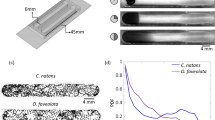Abstract
THE statement in Miss H. Spurway's interesting observations on the above subject1, that it is generally believed that amphibian larvæ are not found in salt or brackish water, is interesting because the brackish slacks or pools between the west Lancashire coastal dunes from Ainsdale to Formby have long been inhabited by breeding specimens of the common smooth newt, common frog, common toad, and natterjack toad. The natterjack is, of course, a well-known breeding inhabitant of brackish estuary waters ; many hundreds breed at Ainsdale; and I have seen its tadpoles in the tide line salt marsh at the Dee mouth between Hilbre Point and Hoylake, Cheshire, and at other estuaries.
This is a preview of subscription content, access via your institution
Access options
Subscribe to this journal
Receive 51 print issues and online access
$199.00 per year
only $3.90 per issue
Buy this article
- Purchase on SpringerLink
- Instant access to full article PDF
Prices may be subject to local taxes which are calculated during checkout
Similar content being viewed by others
References
NATURE, 151, 109 (1943).
Author information
Authors and Affiliations
Rights and permissions
About this article
Cite this article
HARDY, E. Newt Larvæ in Brackish Water. Nature 151, 226 (1943). https://doi.org/10.1038/151226a0
Issue date:
DOI: https://doi.org/10.1038/151226a0
This article is cited by
-
Newt Larvæ in Brackish Water
Nature (1943)



